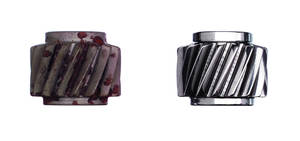Improvement of the surface finish for many parts increases fatigue life and reduces fuel consumption
Increasing demands for higher product quality combined with pressure for cost reductions require new solutions, especially for suppliers of engine and transmission components as well as companies active in the fields of propulsion technology and energy production.
One such solution is the worldwide patented REM Isotropic Superfinish (ISF®) technology. REM Chemicals Inc. and Roesler Oberflaechentechnik GmbH have been cooperating in this field for 2 years with Roesler developing special finishing equipment and ceramic finishing media in conjunction with REM for the ISF process. By smoothing of the parts surface down to Ra of 0.02 µm and Rz of 0.2 µm, the parts operating characteristics with regard to friction, wear and operating temperatures are significantly improved with a substantial increase of the part’s fatigue life. Moreover, the ISF technology allows implementation of product ideas which could not be realized due to constraints in the surface finish.
Is there a relationship between the surface roughness of a gear and the life of the bearings in a transmission? Scientific studies are underway to establish such a relationship. However, in many industries like automotive, aerospace, bearing, medical, textile equipment as well as large gears and motor sports it is considered as a proven fact that the surface smoothness of a part influences significantly the quality and life of such a part. The explanation for this phenomenon is that surface treatment methods like milling, belt and wheel grinding, lapping and honing frequently create a more or less rough surface with many ”peaks”. These peaks can interrupt the oil film - usually 0.2 – 0.5 µm thick - that is required for a reliable lubrication of these high performance parts. This can create gray staining and micro pitting on the critical parts surfaces like, for example on the teeth of a gear. In addition, the friction can break off the peaks creating debris particles. These particles then pass through the component as small chips and can cause damage to the component.
ISF removes the peaks
The ISF technology removes the „peaks“ on many parts made from carbon steel, high alloy steel, stainless steel and titanium. This process usually takes place in vibratory mass finishing systems specially designed by Roesler with dedicated high-density, non-abrasive ceramic media and special REM active chemical compounds. The REM active chemicals compounds create a thin, oxide film on the parts surface with a pH value of between 1.6 – 5.5. Due to the vibratory action in the work bowl the ceramic media „wipes“ off this oxide film. Over time this action removes the „peaks“. The lower lying „valleys“ remain intact and serve as a reservoir for the lubricant. The process continues – with the constant addition of fresh compound – until the required surface finish of Ra 0.02 µm or Rz 0.2 µm is achieved. The actual ISF refinement process is followed by a rinsing/burnishing process in the same machine by dosing a burnishing compound with water into the machine. The rinse/burnish process removes the remaining oxide film from the parts and creates a mat or high gloss finish.
<link file:7043> |
The machine settings of the vibratory mass finishing machine ensure an optimum and gentle movement of the parts and media in the work bowl. The metal removal takes place very gently, thus preventing any nicking of the parts. While the ISF process may produce a slight edge break, it does not produce an excessive radiusing (round edges) of the parts, because the utilized media is non-abrasive. The ISF process takes place at room temperature and does not affect the material properties of the metal component. Furthermore, long-term experience has shown that there is no danger of hydrogen embrittlement. The required process time and compound usage for achieving a certain surface finish usually is determined by sample component processing trials. This allows exact planning of the ISF process within the overall parts manufacturing process. The result is usually a much better surface finish at lower cost.
Advantages that save money!
After the ISF process parts usually have an extremely fine surface finish. Depending on the initial surface roughness this increases the contact area significantly, sometimes up to 90 – 100% (measured at a depth of 0.4 µm). Performance and efficiency of the components are significantly improved which allows to make gear parts smaller or use higher input power motors – at a significantly improved fatigue life! For example the life of gears processed with the ISF technology could be increased 4 to 5 fold. Moreover, the ISF system creates a isotropic structure on the parts surface which substantially improves lubrication, reduces friction and wear, reduces operating noise and reduces operating temperatures. This allows the operator to extend the time interval between preventive maintenance work. Of course, all these quality improvements also lead to energy savings. Last but not least, as pointed out previously, the ISF technology also allows the design of parts which previously would not have been possible. One example is the manufacture of a highly efficient turbine blade which would not have been possible with conventional surface finishing methods.
The right finishing equipment
<link file:7044> |
The ISF process can be applied for parts as small as the head of a match with a weight of less than one gram up to gears with a weight of up to 5,000 kg. This requires specially engineered equipment to achieve cost effective finishing results. Roesler offers a wide range of equipment, like for example double curved wall rotary vibrators. Such rotary vibrators induce an even parts/media rotation in the work bowl allowing a 50% higher fill rate of parts and media compared to straight wall vibrators. At the same time double curved wall vibrators produce a much better surface finish. The ISF technology produces a relatively small amount of effluent. The effluent can be treated with conventional waste water treatment systems. Due to its low wear rate the high density ceramic media used for the ISF process can be used for a long time, before it must be replaced. ISF is a registered trademark of REM Chemicals Inc.
Catalogue of Suppliers: <link _top>Rösler Oberflächentechnik GmbH




